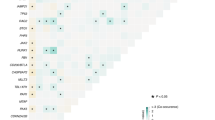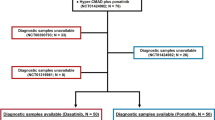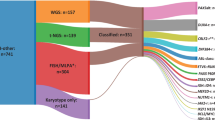Abstract
Relapse is the most common cause of treatment failure in pediatric acute lymphoblastic leukemia (ALL) and is often difficult to predict. To explore the prognostic impact of recurrent DNA copy number abnormalities on relapse, we performed high-resolution genomic profiling of 34 paired diagnosis and relapse ALL samples. Recurrent lesions detected at diagnosis, including PAX5, CDKN2A and EBF1, were frequently absent at relapse, indicating that they represent secondary events that may be absent in the relapse-prone therapy-resistant progenitor cell. In contrast, deletions and nonsense mutations in IKZF1 (IKAROS) were highly enriched and consistently preserved at the time of relapse. A targeted copy number screen in an unselected cohort of 131 precursor B-ALL cases, enrolled in the dexamethasone-based Dutch Childhood Oncology Group treatment protocol ALL9, revealed that IKZF1 deletions are significantly associated with poor relapse-free and overall survival rates. Separate analysis of ALL9-treatment subgroups revealed that non-high-risk (NHR) patients with IKZF1 deletions exhibited a ∼12-fold higher relative relapse rate than those without IKZF1 deletions. Consequently, IKZF1 deletion status allowed the prospective identification of 53% of the relapse-prone NHR-classified patients within this subgroup and, therefore, serves as one of the strongest predictors of relapse at the time of diagnosis with high potential for future risk stratification.
This is a preview of subscription content, access via your institution
Access options
Subscribe to this journal
Receive 12 print issues and online access
$259.00 per year
only $21.58 per issue
Buy this article
- Purchase on Springer Link
- Instant access to full article PDF
Prices may be subject to local taxes which are calculated during checkout

Similar content being viewed by others
References
Pui CH, Relling MV, Downing JR . Acute lymphoblastic leukemia. N Engl J Med 2004; 350: 1535–1548.
Malempati S, Gaynon PS, Sather H, La MK, Stork LC, Children's Oncology Group. Outcome after relapse among children with standard-risk acute lymphoblastic leukemia: Children's Oncology Group study CCG-1952. J Clin Oncol 2007; 25: 5800–5807.
Kuiper RP, Schoenmakers EF, van Reijmersdal SV, Hehir-Kwa JY, Geurts van Kessel A, van Leeuwen FN et al. High-resolution genomic profiling of childhood ALL reveals novel recurrent genetic lesions affecting pathways involved in lymphocyte differentiation and cell cycle progression. Leukemia 2007; 21: 1258–1266.
Mullighan CG, Goorha S, Radtke I, Miller CB, Coustan-Smith E, Dalton JD et al. Genome-wide analysis of genetic alterations in acute lymphoblastic leukaemia. Nature 2007; 446: 758–764.
Kawamata N, Ogawa S, Zimmermann M, Kato M, Sanada M, Hemminki K et al. Molecular allelokaryotyping of pediatric acute lymphoblastic leukemias by high-resolution single nucleotide polymorphism oligonucleotide genomic microarray. Blood 2008; 111: 776–784.
Li AH, Rosenquist R, Forestier E, Lindh J, Roos G . Detailed clonality analysis of relapsing precursor B acute lymphoblastic leukemia: implications for minimal residual disease detection. Leuk Res 2001; 25: 1033–1045.
de Haas V, Verhagen OJ, von dem Borne AE, Kroes W, van den Berg H, van der Schoot CE . Quantification of minimal residual disease in children with oligoclonal B-precursor acute lymphoblastic leukemia indicates that the clones that grow out during relapse already have the slowest rate of reduction during induction therapy. Leukemia 2001; 15: 134–140.
Peham M, Konrad M, Harbott J, König M, Haas OA, Panzer-Grümayer ER . Clonal variation of the immunogenotype in relapsed ETV6/RUNX1-positive acute lymphoblastic leukemia indicates subclone formation during early stages of leukemia development. Genes Chromosomes Cancer 2004; 39: 156–160.
Choi S, Henderson MJ, Kwan E, Beesley AH, Sutton R, Bahar AY et al. Relapse in children with acute lymphoblastic leukemia involving selection of a preexisting drug-resistant subclone. Blood 2007; 110: 632–639.
Mullighan CG, Phillips LA, Su X, Ma J, Miller CB, Shurtleff SA et al. Genomic analysis of the clonal origins of relapsed acute lymphoblastic leukemia. Science 2008; 322: 1377–1380.
Yang JJ, Bhojwani D, Yang W, Cai X, Stocco G, Crews K et al. Genome-wide copy number profiling reveals molecular evolution from diagnosis to relapse in childhood acute lymphoblastic leukemia. Blood 2008; 112: 4178–4183.
Kawamata N, Ogawa S, Seeger K, Kirschner-Schwabe R, Huynh T, Chen J et al. Molecular allelokaryotyping of relapsed pediatric acute lymphoblastic leukemia. Int J Oncol 2009; 34: 1603–1612.
Mullighan CG, Miller CB, Radtke I, Phillips LA, Dalton J, Ma J et al. BCR-ABL1 lymphoblastic leukaemia is characterized by the deletion of Ikaros. Nature 2008; 453: 110–114.
Mullighan CG, Su X, Zhang J, Radtke I, Phillips LA, Miller CB et al. Deletion of IKZF1 and prognosis in acute lymphoblastic leukemia. N Engl J Med 2009; 360: 470–480.
Iacobucci I, Storlazzi CT, Cilloni D, Lonetti A, Ottaviani E, Soverini S et al. Identification and molecular characterization of recurrent genomic deletions on 7p12 in the IKZF1 gene in a large cohort of BCR-ABL1-positive acute lymphoblastic leucemia patients: on behalf of Gruppo Italiano Malattie Ematologiche dell’Adulto Acute Leukemia Working Party (GIMEMA AL WP). Blood 2009; 114: 2159–2167.
Martinelli G, Iacobucci I, Storlazzi CT, Vignetti M, Paoloni F, Cilloni D et al. IKZF1 (Ikaros) deletions in BCR-ABL1-positive acute lymphoblastic leukemia are associated with short disease-free survival and high rate of cumulative incidence of relapse: a GIMEMA AL WP report. J Clin Oncol 2009; 27: 5202–5207.
Den Boer ML, van Slegtenhorst M, De Menezes RX, Cheok MH, Buijs-Gladdines JG, Peters ST et al. A subtype of childhood acute lymphoblastic leukaemia with poor treatment outcome: a genome-wide classification study. Lancet Oncol 2009; 10: 125–134.
Veerman AJ, Kamps WA, van den Berg H, van den Berg E, Bökkerink JP, Bruin MC et al. Dexamethasone-based therapy for childhood acute lymphoblastic leukaemia: results of the prospective Dutch Childhood Oncology Group (DCOG) protocol ALL-9 (1997-2004). Lancet Oncol 2009; 10: 957–966.
Nannya Y, Sanada M, Nakazaki K, Hosoya N, Wang L, Hangaishi A et al. A robust algorithm for copy number detection using high-density oligonucleotide single nucleotide polymorphism genotyping arrays. Cancer Res 2005; 65: 6071–6079.
Hehir-Kwa JY, Egmont-Petersen M, Janssen IM, Smeets D, Geurts van Kessel A, Veltman JA . Genome-wide copy number profiling on high-density bacterial artificial chromosomes, single-nucleotide polymorphisms, and oligonucleotide microarrays: a platform comparison based on statistical power analysis. DNA Res 2007; 14: 1–11.
Schouten JP, McElgunn CJ, Waaijer R, Zwijnenburg D, Diepvens F, Pals G . Relative quantification of 40 nucleic acid sequences by multiplex ligation-dependent probe amplification. Nucleic Acids Res 2002; 30: e57.
van Dongen JJM, Langerak AW, Bruggemann M, Evans PAS, Hummel M, Lavender FL et al. Design and standardization of PCR primers and protocols for detection of clonal immunogloulin and T-cell receptor gene recombinations in suspect lymphoproliferations. Leukemia 2003; 17: 2257–2317.
Szczepanski T, van der Velden VHJ, Hoogeveen PG, De Bie M, Jacobs DCH, Van Wering ER et al. V{delta}2-J{alpha} gene rearrangements are frequent in precursor-B-acute lymphoblastic leukemia but rare in normal lymphoid cells. Blood 2004; 103: 3798–3804.
Szczepanski T, Willemse MJ, van Wering ER, van Weerden JF, Kamps WA, van Dongen JJM . Precursor-B-ALL with D(H)-J(H) gene rearrangements have an immature immunogenotype with a high frequency of oligoclonality and hyperdiploidy of chromosome 14. Leukemia 2001; 15: 1415–1423.
Verhagen OJ, Willemse MJ, Breunis WB, Wijkhuijs AJ, Jacobs DC, Joosten SA et al. Application of germline IGH probes in real-time quantitative PCR for the detection of minimal residual disease in acute lymphoblastic leukemia. Leukemia 2000; 14: 1426–1435.
Pongers-Willemse MJ, Seriu T, Stolz F, d’Aniello E, Gameiro P, Pisa P et al. Primers and protocols for standardized detection of minimal residual disease in acute lymphoblastic leukemia using immunoglobulin and T cell receptor gene rearrangements and TAL1 deletions as PCR targets: report of the BIOMED-1 CONCERTED ACTION: investigation of minimal residual disease in acute leukemia. Leukemia 1999; 13: 110–118.
Szczepanski T, Van der Velden VHJ, Raff T, Jacobs DC, van Wering ER, Brüggemann M et al. Comparative analysis of T-cell receptor gene rearrangements at diagnosis and relapse of T-cell acute lymphoblastic leukemia (T-ALL) shows high stability of clonal markers for monitoring of minimal residual disease and reveals the occurrence of second T-ALL. Leukemia 2003; 17: 2149–2156.
Mullighan CG, Zhang J, Harvey RC, Collins-Underwood JR, Schulman BA, Phillips LA et al. JAK mutations in high-risk childhood acute lymphoblastic leukemia. Proc Natl Acad Sci USA 2009; 106: 12944–12949.
Acknowledgements
We thank Drs Ellen van der Schoot, Jeltje de Vries, Peggy Manders, Paul N Span, Jayne Hehir-Kwa, Suzanne T M Keijzers-Vloet and Eugène Verwiel for their advice and support. This work was supported by grants from the Dutch Cancer Society (KUN2009-4298; RPK, AGvK and PMH), KiKa (FNvL, PMH and RPK) and the Quality of Life Gala Foundation (PMH, FNvL, AGvK and RPK).
Author information
Authors and Affiliations
Corresponding author
Ethics declarations
Competing interests
The authors declare no conflict of interest.
Additional information
The SNP array data discussed in this publication have been deposited in NCBI's Gene Expression Omnibus (GEO, http://www.ncbi.nlm.nih.gov/geo/) under accession number GSE 20353.
Supplementary Information accompanies the paper on the Leukemia website
Supplementary information
Rights and permissions
About this article
Cite this article
Kuiper, R., Waanders, E., van der Velden, V. et al. IKZF1 deletions predict relapse in uniformly treated pediatric precursor B-ALL. Leukemia 24, 1258–1264 (2010). https://doi.org/10.1038/leu.2010.87
Received:
Revised:
Accepted:
Published:
Issue Date:
DOI: https://doi.org/10.1038/leu.2010.87
Keywords
This article is cited by
-
‘Evaluation of adverse prognostic gene alterations & MRD positivity in BCR::ABL1-like B-lineage acute lymphoblastic leukaemia patients, in a resource-constrained setting
British Journal of Cancer (2023)
-
Dominant-negative type of IKZF1 deletion showed a favorable prognosis in adult B-cell acute lymphoblastic leukemia
Annals of Hematology (2023)
-
Measurable residual disease analysis in paediatric acute lymphoblastic leukaemia patients with ABL-class fusions
British Journal of Cancer (2022)
-
Increased Incidence of IKZF1 deletions and IGH-CRLF2 translocations in B-ALL of Hispanic/Latino children—a novel health disparity
Leukemia (2021)
-
Dual targeting of MTOR as a novel therapeutic approach for high-risk B-cell acute lymphoblastic leukemia
Leukemia (2021)



